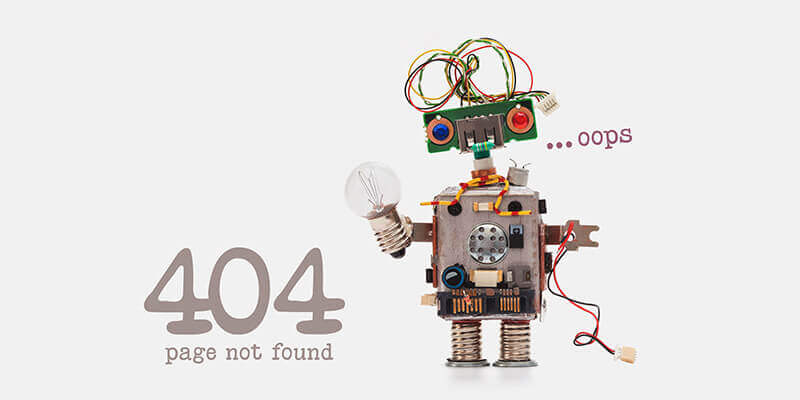If your website isn’t performing as well as you’d like, check out our list of possible culprits, and make the needed changes to transform your site into a lead-generating machine.
1.PEOPLE CAN’T FIND YOU ONLINE
The truth is, your website may not be failing at all. What’s more likely is that users are unable to find you online, and having a website with no search visibility is like opening a brick and mortar store with no street sign.
An effective marketing team will tell you that the first step in establishing your company’s online presence should be to craft a thorough SEO (search engine optimization) strategy, which should be built upon the principles of RAP:
– Relevance – Accessibility – PopularityDoing so will ensure that the website you invested thousands of hard-earned dollars into will be easily found by your ideal customers in your primary target markets. Learn more about our approach to SEO by reading SEO Basics for Small Business.
2. IT DOESN’T WORK ON MOBILE
In 2014, a critical internet usage milestone was reached when for the first time, more online traffic came from mobile users than desktop users. With this mobile trend continuing to strengthen, you simply cannot afford to have a website which is not mobile-friendly (responsive) in 2019. Learn more about why being mobile friendly matters here.
By failing to make the switch to a responsive site, you could be preventing more than half of your potential online customers from interacting with your business. Not only that, but Google has officially begun penalizing websites that are not mobile-friendly in their search results – DOUBLE WHAMMY!
Not sure how to tell if your website is mobile-friendly? Take the test here: Google Mobile Friendly Test
3. IT’S DIFFICULT TO NAVIGATE

In the digital age, users have very short attention spans, and if your website has complex navigation menus, pages of unorganized content, or a confusing site architecture, they will immediately leave and visit the site of one of your competitors to find the information they’re seeking.
Like it or not, this is the reality of online marketing, and your most important mission in designing a successful website should be to provide your potential customers with easy to find solutions to the problems they are trying to solve.
4. THERE IS NO CONTENT STRATEGY
In our experience, most companies are worried too much about how their website LOOKS, and not enough about what their website SAYS, which can lead to very disappointing results over time.Don’t get me wrong, a beautiful web design can greatly improve your ability to connect with potential customers, but implementing a content strategy will more effectively impact your ability to achieve two very important goals:
- Gaining Better Search Rank: Having high-quality, keyword-focused content on your website enhances your industry credibility, thus increasing the likelihood that Google will rank you higher for industry specific keyword searches. It is now common knowledge that Google uses content quality as a critical ranking factor within their algorithm – use this knowledge to your advantage! Google Ranking Factors
- Building Stronger Relationships: Rich content will build trust with potential customers, and establish your company as an industry authority. 81% of shoppers conduct online research on a business before making a purchase (Learn More) , meaning that if you can demonstrate your expertise through your website, social media platforms, and email marketing, you’ll be much more likely to convert visitors into leads, and leads into sales.
5. IT LOOKS OUTDATED
While we’re often told to “not judge a book by its cover”, the reality is that your website is your company’s first impression with online customers, and they will most certainly judge the quality of your products or services based on that online experience. That’s right, the reputation you spent decades building may mean nothing to a user who sees a website that was built 15 years ago. People want fresh and modern solutions to their problems, and visiting an outdated website likely tells them at least one of three things:
- This company is “old-school”, and doesn’t understand the problems I’m facing.
- This company doesn’t care enough about their own reputation (or their customers) to modernize their website.
- This company probably went out of business years ago.
If these are the thoughts your users are having during their first interaction with your business, what do you think your chances of success are in converting them into paying customers?
6. THERE ARE BROKEN FEATURES

Going back to first impressions, it’s worth noting that even a brand new, state-of-the-art web design can leave users with a bad taste in their mouths, that is, if there are parts of the design that are broken.
If you’ve ever stayed at an expensive hotel, you know that issues like a broken thermostat, or a toilet that won’t flush, can quickly reduce a five-star rating to a one-star disaster, and the same is true for your website.
Broken features are easily perceived by users to be a symptom of negligence, and unfortunately that may lead them to believe that you are also negligent when it comes to other areas of your business, such as the quality of your products, or the level of customer service that you offer. This can be especially damaging for websites that process payments, as it will be an immediate red flag to anyone concerned with the security of their payment information!
7. YOU’RE NOT TRACKING ANALYTICS
“Set it and forget it” may have been a great slogan for Ronco’s famous Rotisserie Cooker , but it’s a terrible strategy to use for online marketing.
A successful website is one that continues to change and adapt to its ever-changing user base. Your products, customers, and business identity change over time, so why wouldn’t your website?
If you haven’t integrated with Google Analytics, you’re missing out on valuable data related to your users’ behavior which can be used to enhance your website and make it a more effective marketing tool over time. Once integrated, you’ll be able to precisely track critical data points, including:
- Bounce Rate: The percentage of users that leave your site after seeing only the home page
- Session Duration: How long the average user spends browsing your website
- Visits: How many users visit your website within a given time frame
- Traffic Source Mediums: Which channels do visitors use to get to your website (i.e., search, social media, paid search, other websites, etc.)
- User Location: In what cities are most of your users located?
By analyzing this data, you can make tweaks to your content strategy to more effectively connect with users over time, thus improving the number of generated leads, and eventually your revenue. Knowledge is power, and Google Analytics can be a priceless source of information.
8. YOU AREN’T OPTIMIZED FOR CONVERSION
Too many web designers will dive head-first into colors, images, and layouts before taking a moment to consider the goals of your expected users. A quality web design should be structured around your company’s unique buyer journeys. A buyer journey is the steps you expect a user to complete as they become a converted customer. A typical buyer journey consists of three phases:
- Awareness Phase
- Consideration Phase
- Decision Making Phase
The sub-steps within this process look slightly different for every company, depending on multiple factors including your target markets, the industry you operate within, and the user types you interact with.
By identifying your buyer journeys first, you can then build a website which is optimized for conversion, including pages, content, and calls-to-action that intentionally provoke users to take specific steps toward your primary conversion goal, such as downloading a brochure, submitting a contact form, or buying a product.
9. YOUR SITE TAKES TOO LONG TO LOAD

Waiting…
Waiting…
Waiting…
GONE.
It’s estimated that 40% of users will leave a site if it takes longer than three seconds to load, which isn’t very much time! Luckily there are several steps you can take to improve your page load speed, and prevent users from abandoning your site for a competitor.
First, run a page load speed test over at pingdom.com, and if your results are lackluster, be sure to do the following:
- Pick a quality web host with fast server response times (we recommend Flywheel Hosting)
- Don’t use too many large, high-resolution images
- Optimize your images by compressing the files
- Minify the HTML, CSS, and JavaScript files on your website
- Avoid redundant script calls on the page
Some of these steps will require a bit more technical knowledge than others, so be sure to consult a web expert before trying to implement them yourself.
10. YOUR ONLINE MARKETING BUDGET ISN’T HIGH ENOUGH
Easy thing for a marketer to say, right? Before I ruffle your feathers too much, let me clarify.
Effective marketing can be achieved without breaking the bank, and anyone who tells you otherwise may be more focused on reaching into your pockets than helping you find the right solution. That said, depending on your industry, and the level of competition you face online, it may be necessary to adjust your expectations for what quality marketing should cost.
20 years ago, just having a website was enough to put you ahead of the competition. The internet was still in its public infancy, and companies were just beginning to see the potential value of having an established web presence.
Fast forward to today, and almost everyone has a website. Further, there are literally hundreds of companies fighting for the same 10 available spots on Google’s page one rankings for important keywords. Given the rules of supply and demand, trying to stand out from the crowd is requiring ever larger investments of time, effort, and money.
Luckily, your marketing costs are only “expensive” if they don’t yield results which recoup your investment. An effective website, created as part of a broader marketing plan with a sound SEO and content strategy can easily recoup the upfront costs within 6 months to a year (and perhaps even sooner).
For example, if you own a real estate agency, how quickly could a $15,000 marketing investment be recouped if your website were to bring you even ONE additional sale per quarter?
If you own a restaurant, how quickly could costs be recouped if your website helped you regularly fill an additional 2-3 seats throughout the year?
The list of examples goes on, but you can see how this formula can work for any company, of any size, in any industry. Yes, as with most purchases, when it comes to online marketing, “you get what you pay for”. But luckily, if you partner with the right digital team, you can easily get more than what you paid for.
Regardless of which issues your website is facing, the good news is that they can all be corrected! In some instances, it may only require some minor changes that you can execute yourself. More severe problems, however, may warrant enlisting the help of a web professional who can can provide you with the best solution given your unique situation.
Let 2019 be the year that your website stops holding your business back, and starts moving your business forward!

